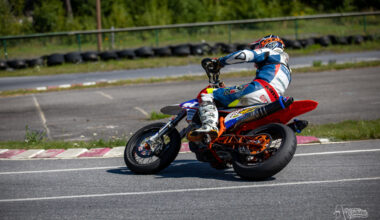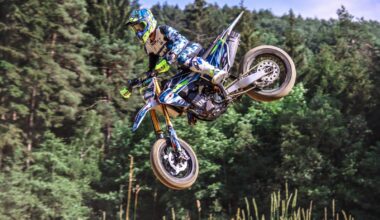Table of Contents
In part 1, we discussed how the bike felt to ride on the track and ended the article by saying that we would follow up and examine the power choices available for the Stark Varg a little closer.
The Varg can be ordered with the choice of 60hp or 80hp. When buying the 60hp model, you can purchase the upgrade for the extra 20hp from Stark for 10,000 SEK (1,000 EUR) afterward. Based on our research on various forums and in conversations with different riders, the consensus seems to be that the 80hp mode is unnecessary for those who ride Enduro or MX; it is simply too much power. But what does it look like for Supermotos?
During our test drive in 60hp mode, as described in our first article, it was clear that the FC450 that was on the track at the same time as us had an advantage as soon as it came to the straights. The Varg simply lacked the power to keep up. We continue to compare the Varg against the Husqvarna FC 450 as this is a base that many people use as a supermoto – FS450/SMR450 are, for example, comparable.
Stark Varg vs Husqvarna FC 450 on the Dyno
Husqvarna does not specify the FC450’s power (hp/Nm) numbers, but our friends over at Speedstore in Gävle have tested several bikes of that model in their Dynojet bench, and we see from the data that they produce around 56hp/45Nm. So how come a 60hp Varg isn’t enough to be competitive against an FC450 on a straight?
If we start looking into the numbers, we can see that there is a difference between the stated power and the measured power. Manufacturers are generally happy to specify the power on the motor instead of the rear wheel. That means they do not have to consider power losses through the drivetrain and they can specify a higher number on paper. As a general rule, you lose about 15% of the power through the drivetrain, with a quick calculation according to this thesis, that would then mean that the FC450’s engine power is closer to 66hp/52Nm.

When we measure power on a Dyno, a sensor on the ignition cable allows the Dyno to know the engine’s rpm. However, the Varg doesn´t have an ignition cable, so the Dyno can only measure horsepower.
Since our Varg is limited to 60hp, due to a manufacturer-identified error in the software that we will return to later, we cannot achieve and measure 80hp. The Dyno measures 62hp max at 62km/h. Since we know the gear ratio in the engine and drivetrain, we can calculate the torque on the rear wheel to ~72Nm.
In the battle between the Husqvarna FC450 vs the Varg on the Dyno, the numbers show 56hp/45Nm (FC450) vs 62hp/72Nm (Varg). But that still doesn’t explain why we were left in the dust?
The Varg´s power curve tells us that we may have a small issue. The Varg reaches max power, 62hp, at 62km/h. This means that as we keep pushing and increasing the speed, the power will start to decrease. The Husqvarna, on the other hand, has a gearbox, which makes it possible to use the engine’s power peak several times during acceleration, in fact, as many times as you have number of gears. The Varg has a maximum torque that is reached at ~75km/h. At 86km/h the torque has decreased by 10%, and at 127km/h it´s cut in half. The FC450 shifts into top gear at 105km/h and reaches its last torque max at ~140km/h, and continues to rev to ~160km/h. The Varg´s top speed with stock gearing is ~145km/h.
While riding our Varg on the track, there was no doubt that there was a lack of power against the Husqvarna that we were riding against. Exiting the corner, we had no problem keeping him behind us, but as soon as the speed crept up to 90-100km/h he pulled past and away. A simple solution to the problem would be to change the gearing to e.g. 15/42, which would give us a top speed of ~180 km/h. It would move the power higher up in the speed range, but the large torque that is available at low revs means that you still maintain most of that acceleration.

Limited 80hp uppgrade
Our bike was bought as an 80hp model. After test-riding it last autumn, it was obvious that the difference between the 60-80hp modes, which you can change in the software, was very small. Barely noticeable on the track, actually. Which was strange. Our experience was also confirmed by the Dynoruns we conducted with Speedstore. Armed with data from the three different Dyno testing occasions that we have performed to be able to help with verification between different presented solutions, we’ve had a long winter with many emails between us and Stark’s support to try to convince them that something isn´t right.
Stark has its own Dyno in Barcelona, and Stark used it to run one of their bikes in that Dyno that they equipped with the software from our bike to troubleshoot and see if they could figure out what was wrong. After many long emails with the support, we have finally agreed that the bike is lacking power. As it turns out, all the “alpha” models are missing those last 20hp due to a software error. We were offered to have an older version of the software installed to give us the missing power. When the offer came, we chose, since it was during the off-season, to wait because a major update was stated to be on the way “before the season starts.”
But now that the season is underway, we wanted to have our missing power back and asked for the older update in the absence of the upcoming one, it turned out Stark is no longer willing to update with that older software due to minor updates having been pushed, and that potentially could create conflicts. The update that will solve the problem, as we are told now, is planned in about one month’s time, which in terms of planning should land somewhere in July 2024, which would be in the middle of the Swedish high-season for riding. At the time of writing, in the middle of June 2024, we still only have 60hp available, even though we initially ordered and paid for 80hp.
A hot lap
In addition, we have heard indications elsewhere of problems with the engine running hot at high power outputs. One rider claims to only be able to ride five or six laps on track before the electronics lowered the power due to high heat.
To verify these claims, we took the Varg to Tuvängen Ring in May 2024. We were able to establish that on the track in question, while riding a lap that includes the dirt section (which results in lower average speeds and power output), the engine seems to have enough time to cool down to last for an entire race heat. But when we used it on just the tarmac only (no gravel section at all) on Tuvängen’s track, it took about 9 laps for us before the engine was too hot and the power was restricted. The air temperature was around 22 degrees during the day, and one lap took about 40-41 seconds.
Our conclusions of the Stark Varg as a Supermoto
After noting the problem with the heat development at Tuvängen and that the engine is running hot at 60hp power output, Stark continues to let us know that “it’s not built for supermoto“, “we’ve never promised that it will be able to run as a supermoto“.
The claims that Stark marketed the bike with just over two years ago were “range like a full tank of gasoline on a 450” and “Complete an MXGP heat.” Maybe it was a misjudgment on our part, but we assumed that if a professional rider can run an MXGP heat on it, we, as amateurs, should be able to do practice sessions on a supermoto track. But in our own experience and judgment, it has turned out that this is not the case. And, as for the range available, on the smaller supermoto track in Borlänge, we could only run the bike 33 laps before the battery was depleted, approximately 22 minutes at our amateur speed. For those of you who follow MXGP, you know that a heat takes around 30 minutes.
Maybe it’s not a mistake that we’re not getting those 20hp we want, and paid for. The engine package might not be designed for the power Stark has sold us? If you keep the power down, it´s possible to ride it for longer. Enduro/MX riders seem to run at around 35-45hp and do not have any direct problems with heat development.
Remember the Alta Redshift MXR? There are many similarities between the Varg and the Alta. The motor, for example, looks very familiar.
Alta on the left below and the Stark Varg on the right.


The Alta also had issues with the heat, but from what you can read on the internet, they still seem to have managed to get something like 50hp/57Nm out of that bike.
So what has Stark actually improved since the Alta was on the market? The 80hp mode is not available at the time of writing. Will the update arrive in July, as promised? We don’t know.
60hp still seems to be too much for the engine to cool itself in environments such as Tuvängen Ring and with only asphalt riding, is 50hp maybe as much as this engine can handle?


The Stark Varg is marketed and sold as a premium product with 80hp/938Nm. In our tests, it performs equally, or less, as the Alta MXR, which was on the market six years ago. We pay for an innovative product but the bike itself seems to be more of an upgraded design of an older model.
We would also like to specifically note that as an electric bike rider today, you cannot count on fast charging between heats on the tracks’ supplied electricity due to network limitations. You (ironically) probably also need to invest in a gasoline-powered generator, model large, to charge the motorcycle reliably. Hopefully, the charging opportunities will be expanded over time as electric vehicles become more common on our tracks around the country.
We recommend that you, as a supermoto rider, think twice before investing in a Stark Varg as your primary motorcycle, especially if you are going to race competitively. Carefully weigh the pros and cons of the limitations that exist today.
We have sold our Varg and are returning to riding a bike that can be ridden – without the machine itself being the limitation.
This post is also available in: Svenska









